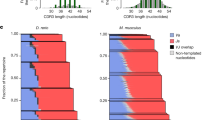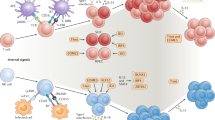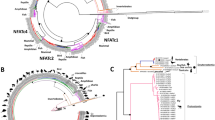Abstract
Lymphoid organs are important regulators of lymphocyte development and immune responses. During vertebrate evolution, primary lymphoid organs appeared earlier than secondary lymphoid organs. Among the sites of primary lymphopoiesis during evolution and ontogeny, those for B cell differentiation have differed considerably, although they often have had myelolymphatic characteristics. In contrast, only a single site for T cell differentiation has occurred, exclusively the thymus. Based on those observations and the known features of variable-diversity-joining gene recombination, we propose a model for the successive specification of different lymphocyte lineages during vertebrate evolution. According to our model, T cells were the first lymphocytes to acquire variable-diversity-joining–type receptors, and the thymus was the first lymphoid organ to evolve in vertebrates to deal with potentially autoreactive, somatically diversified T cell receptors.
This is a preview of subscription content, access via your institution
Access options
Subscribe to this journal
Receive 12 print issues and online access
$209.00 per year
only $17.42 per issue
Buy this article
- Purchase on Springer Link
- Instant access to full article PDF
Prices may be subject to local taxes which are calculated during checkout


Similar content being viewed by others
References
Porter, R. The Greatest Benefit to Mankind: A Medical History of Humanity from Antiquity to the Present (Harper-Collins, New York, 1997).
Miller, J.F. Immunological function of the thymus. Lancet 2, 748–749 (1961).
Le Douarin, N. The microenvironment of T and B lymphocyte differentiation in avian embryos. Curr. Top. Dev. Biol. 20, 291–313 (1986).
Tonegawa, S. Somatic generation of antibody diversity. Nature 302, 575–581 (1983).
Pancer, Z. & Cooper, M.D. The evolution of adaptive immunity. Annu. Rev. Immunol. 24, 497–518 (2006).
Watson, F.L. et al. Extensive diversity of Ig-superfamily proteins in the immune system of insects. Science 18, 1826–1827 (2005).
Royet, J., Reichhart, J.M. & Hoffmann, J.A. Sensing and signaling during infection in Drosophila. Curr. Opin. Immunol. 17, 11–17 (2005).
Dong, Y., Taylor, H.E. & Dimopoulos, G. AgDscam, a hypervariable immunoglobulin domain-containing receptor of the Anopheles gambiae innate immune system. PLoS Biol. 4, e229 (2006).
Alder, M.N. et al. Diversity and function of adaptive immune receptors in a jawless vertebrate. Science 310, 1970–1973 (2005).
Davis, M.M. & Bjorkman, P.J. T-cell antigen receptor genes and T-cell recognition. Nature 334, 395–402 (1988).
Boehm, T. Quality control in self/nonself discrimination. Cell 125, 845–858 (2006).
Medzhitov, R. & Janeway, C.A., Jr. Decoding the patterns of self and nonself by the innate immune system. Science 296, 298–300 (2002).
Meylan, E., Tschopp, J. & Karin, M. Intracellular pattern recognition receptors in the host response. Nature 442, 39–44 (2006).
Pancer, Z. et al. Somatic diversification of variable lymphocyte receptors in the agnathan sea lamprey. Nature 430, 174–180 (2004).
Pancer, Z. et al. Variable lymphocyte receptors in hagfish. Proc. Natl. Acad. Sci. USA 102, 9224–9229 (2005).
Cannon, J.P., Haire, R.N., Rast, J.P. & Litman, G.W. The phylogenetic origins of the antigen-binding receptors and somatic diversification mechanisms. Immunol. Rev. 200, 12–22 (2004).
Kondo, M., Scherer, D.C., King, A.G., Manz, M.G. & Weissman, I.L. Lymphocyte development from hematopoietic stem cells. Curr. Opin. Genet. Dev. 11, 520–526 (2001).
Hardy, R.R. & Hayakawa, K. B cell development pathways. Annu. Rev. Immunol. 19, 595–621 (2001).
Schwarz, B.A. & Bhandoola, A. Trafficking from the bone marrow to the thymus: a prerequisite for thymopoiesis. Immunol. Rev. 209, 47–57 (2006).
Boehm, T. & Bleul, C.C. Thymus-homing precursors and the thymic microenvironment. Trends Immunol. 27, 477–484 (2006).
Du Pasquier, L. Ontogeny of the immune response in cold-blooded vertebrates. Curr. Top. Microbiol. Immunol. 61, 37–88 (1973).
Knight, K.L. & Crane, M.A. Generating the antibody repertoire in rabbit. Adv. Immunol. 56, 179–218 (1994).
Tagaya, H. et al. Intramedullary and extramedullary B lymphopoiesis in osteopetrotic mice. Blood 95, 3363–3370 (2000).
Li, J. et al. B lymphocytes from early vertebrates have potent phagocytic and microbicidal abilities. Nat. Immunol. 7, 1116–1124 (2006).
Cumano, A., Paige, C.J., Iscove, N.N. & Brady, G. Bipotential precursors of B cells and macrophages in murine fetal liver. Nature 356, 612–615 (1992).
Montecino-Rodriguez, E., Leathers, H. & Dorshkind, K. Bipotential B-macrophage progenitors are present in adult bone marrow. Nat. Immunol. 2, 83–88 (2001).
Ardavin, C.F. & Zapata, A. Ultrastructure and changes during metamorphosis of the lympho-hemopoietic tissue of the larval anadromous sea lamprey Petromyzon marinus. Dev. Comp. Immunol. 11, 79–93 (1987).
Shintani, S. et al. Do lampreys have lymphocytes? The Spi evidence. Proc. Natl. Acad. Sci. USA 97, 7417–7422 (2000).
Ardavin, C.F. & Zapata, A. The pharyngeal lymphoid tissue of lampreys. A morpho-functional equivalent of the vertebrate thymus? Thymus 11, 59–65 (1988).
Pancer, Z., Mayer, W.E., Klein, J. & Cooper, M.D. Prototypic T cell receptor and CD4-like coreceptor are expressed by lymphocytes in the agnathan sea lamprey. Proc. Natl. Acad. Sci. USA 101, 13273–13278 (2004).
Sakano, H., Huppi, K., Heinrich, G. & Tonegawa, S. Sequences at the somatic recombination sites of immunoglobulin light-chain genes. Nature 280, 288–294 (1979).
Agrawal, A., Eastman, Q.M. & Schatz, D.G. Transposition mediated by RAG1 and RAG2 and its implications for the evolution of the immune system. Nature 394, 744–751 (1998).
Hiom, K., Melek, M. & Gellert, M. DNA transposition by the RAG1 and RAG2 proteins: a possible source of oncogenic translocations. Cell 94, 463–470 (1998).
Kapitonov, V.V. & Jurka, J. RAG1 core and V(D)J recombination signal sequences were derived from Transib transposons. PLoS Biol 3, e181 (2005).
Eason, D.D. et al. Mechanisms of antigen receptor evolution. Semin. Immunol. 16, 215–226 (2004).
Boehm, T. Co-evolution of a primordial peptide-presentation system and cellular immunity. Nat. Rev. Immunol. 6, 79–84 (2006).
Dishaw, L.J., Smith, S.L. & Bigger, C.H. Characterization of a C3-like cDNA in a coral: phylogenetic implications. Immunogenetics 57, 1–14 (2005).
Litman, G.W., Cannon, J.P. & Dishaw, L.J. Reconstructing immune phylogeny: new perspectives. Nat. Rev. Immunol. 5, 866–879 (2005).
Nemazee, D. Receptor editing in lymphocyte development and central tolerance. Nat. Rev. Immunol. 6, 728–740 (2006).
Nehls, M. et al. Two genetically separable steps in the differentiation of thymic epithelium. Science 272, 886–889 (1996).
Ivanov, I.I. & Diehl, G.E. & Littman, D.R. Lymphoid tissue inducer cells in intestinal immunity. Curr. Top. Microbiol. Immunol. 308, 59–82 (2006).
Drayton, D.L., Liao, S., Mounzer, R.H. & Ruddle, N.H. Lymphoid organ development: from ontogeny to neogenesis. Nat. Immunol. 7, 344–353 (2006).
Austen, K.F. & Fearon, D.T. A molecular basis of activation of the alternative pathway of human complement. Adv. Exp. Med. Biol. 120B, 3–17 (1979).
Matsunaga, T. & Rahman, A. What brought the adaptive immune system to vertebrates?–The jaw hypothesis and the seahorse. Immunol. Rev. 166, 177–186 (1998).
Kyewski, B. & Derbinski, J. Self-representation in the thymus: an extended view. Nat. Rev. Immunol. 4, 688–698 (2004).
Cordier, A.C. & Haumont, S.M. Development of thymus, parathyroids, and ultimo-branchial bodies in NMRI and nude mice. Am. J. Anat. 157, 227–263 (1980).
Rossi, S.W., Jenkinson, W.E., Anderson, G. & Jenkinson, E.J. Clonal analysis reveals a common progenitor for thymic cortical and medullary epithelium. Nature 441, 988–991 (2006).
Bleul, C.C. et al. Formation of a functional thymus initiated by a postnatal epithelial progenitor cell. Nature 441, 992–996 (2006).
Acknowledgements
Supported by the Max-Planck Society.
Author information
Authors and Affiliations
Ethics declarations
Competing interests
The authors declare no competing financial interests.
Rights and permissions
About this article
Cite this article
Boehm, T., Bleul, C. The evolutionary history of lymphoid organs. Nat Immunol 8, 131–135 (2007). https://doi.org/10.1038/ni1435
Published:
Issue Date:
DOI: https://doi.org/10.1038/ni1435
This article is cited by
-
Application of Nano-Delivery Systems in Lymph Nodes for Tumor Immunotherapy
Nano-Micro Letters (2023)
-
The potential of non-myeloablative heterochronous autologous hematopoietic stem cell transplantation for extending a healthy life span
GeroScience (2018)
-
Dissecting the role of transforming growth factor-β1 in topmouth culter immunobiological activity: a fundamental functional analysis
Scientific Reports (2016)
-
Autoimmunity and tumor immunology: two facets of a probabilistic immune system
BMC Systems Biology (2014)



